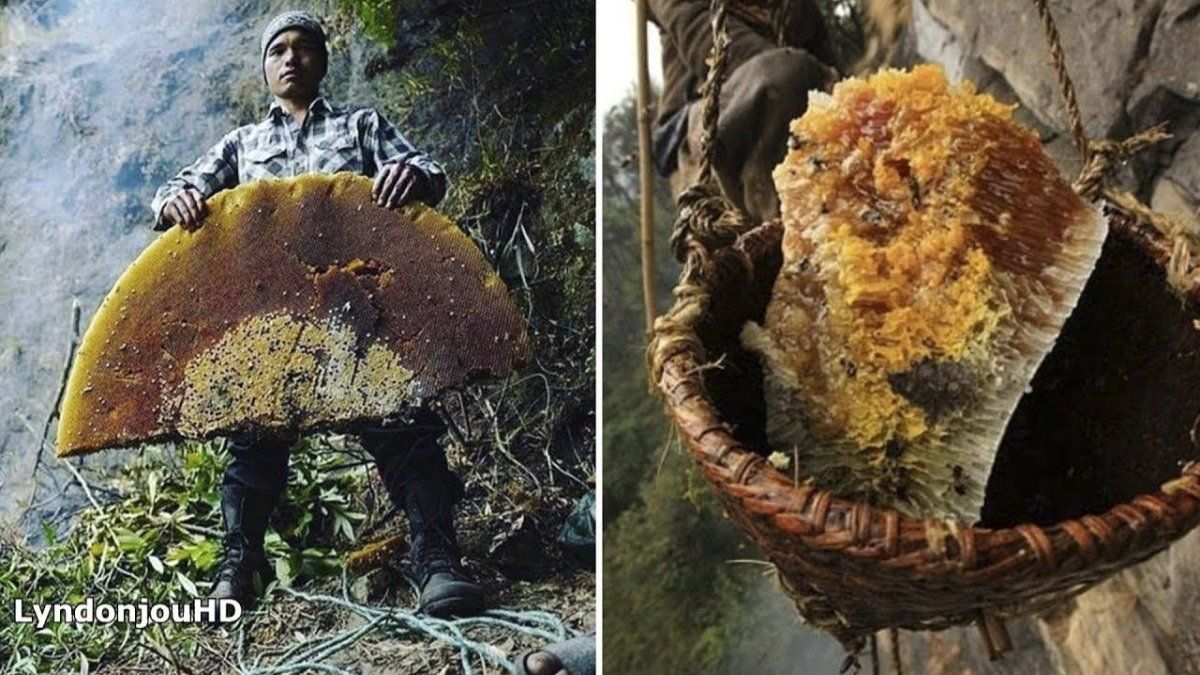Shrouded in smoke to protect himself from attacks by a swarm of giant bees and hanging 100 metres above the ground, 26-year-old Som Ram Gurung cuts away dripping sections from several wild hives in Lamjung district in central Nepal.
“Mad honey,” derived from rhododendron nectar, which bees love, has a spicy taste and, according to its followers, a mild hallucinogenic effect.
Due to the great height at which it is produced, it is not easy to harvest. It is the work of the Apis laboriosa species, the largest bee in the world (up to 3 centimetres long), which is usually present in the most inaccessible gorges.
But that is not the only challenge facing honey hunters today, as climate change is posing additional challenges in these remote valleys, 100km northwest of Kathmandu.
Doodh Bahadur Gurung, 65, has passed on his skills to his son, Som Ram. He says the collectors have seen a rapid decline in the number of hives and the amount of honey harvested.
“When we were young, there were beehives on almost every cliff because of the abundance of wild flowers and water sources,” explains Doodh Bahadur. “But every year it is harder to find” beehives, he notes.
The decline of bees is explained by multiple causes: “watercourses are drying up due to hydroelectric projects and irregular rainfall,” he says.
“Bees flying to farms are also faced with the problem of pesticides, which kill them,” he added.
The combination of increasingly dry winters, increasingly irregular rainfall and stifling heat has made forest fires more common.
Nepal has seen more than 4,500 forest fires this year, almost double the number from a year earlier, according to the government.
Ten years ago, up to 1,000 litres of honey could be collected in Doodh Bahadur village per season. Today, collectors are lucky to get 250 litres.
Scientists confirm these observations, pointing out that climate change is a determining factor.
“Bees are very sensitive to temperature changes,” says Susma Giri, a bee specialist at the Kathmandu Institute of Applied Sciences.
“They are wild creatures that cannot adapt to human activities or noise.”
The Nepal-based International Centre for Integrated Mountain Development (ICIMOD) has noted a rate of melting of Himalayan glaciers never seen before, as well as a “dramatic decline in the bee population.”
On the economic front, annual losses caused by reduced pollination in Nepal amounted to $250 per capita in 2022, according to a study published that year in the journal Environmental Health Perspectives. This is a huge sum, considering that the average annual income of Nepalese is $1,400.
The dwindling reserves have caused the price of this rare honey to skyrocket. Twenty years ago, a litre cost 3.50 dollars; now it sells for 15.
According to traders, demand for it has increased in the United States, Europe and Japan, due to its supposed beneficial effects, widely spread on social media.
Honey traders in Kathmandu estimate that around 10,000 litres of honey are exported abroad each year.
A 250-gram jar of “mad honey” can fetch up to $70 online. Demand “increases every year but quality production has declined,” says Rashmi Kandel, a honey exporter in the Nepalese capital.
There are fewer and fewer young people willing to dedicate themselves to this activity, which lasts a month.
As is happening across the country, young people are abandoning rural life to pursue better-paid jobs abroad.
Som Ram Gurung stretches out his swollen arms and legs after climbing down the cliff. “I have bites all over my body,” he says. He says he would be willing to go work in a factory in Dubai for a monthly salary of about $320.
His father, Doodh Bahadur, regrets both the disappearance of the bees and the departure of the young people. “We are losing everything,” he says. “The future is uncertain for everyone.”
Source: Ambito




